Soap making oils fall into three main categories: soft (liquid at room temperature), hard (solid), and brittle (quick-setting). Each contributes different properties to your finished soap. Soft oils like olive provide gentleness, hard oils like coconut create abundant lather, and specialty oils add luxury benefits. The balance you choose affects hardness, lather quality, cleansing strength, and trace time. Understanding these oil characteristics helps you craft soaps perfectly suited to your skin's needs.
12 Second-Level Headings for "What Soap Making Oils Actually Do: Master Chart"
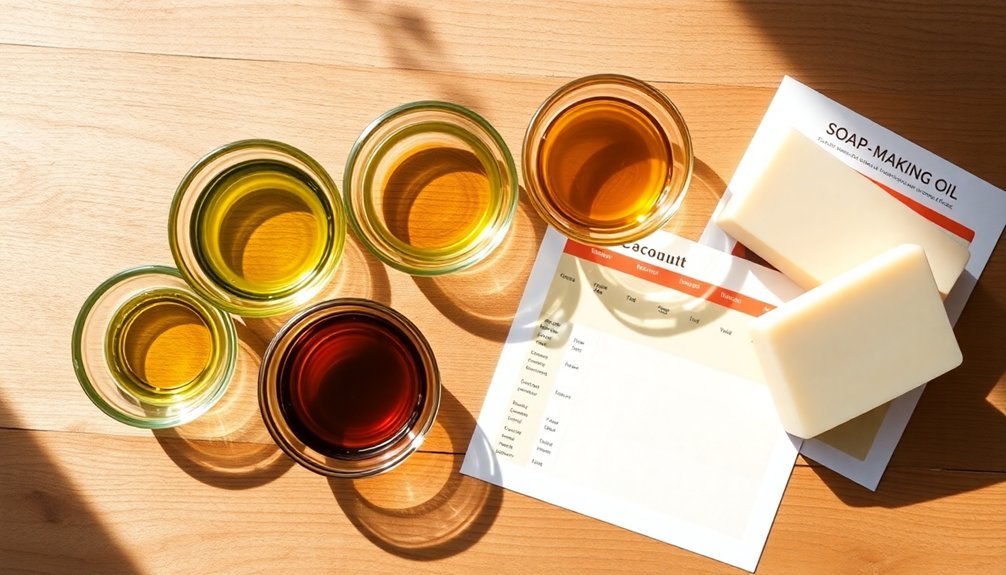
When exploring the world of soap making, understanding how different oils affect your final product is essential. The Master Chart organizes oils by their primary contributions to your soap – hardness, conditioning, cleansing, and lather qualities.
Hard oils like coconut and palm create solid bars with abundant lather, while soft oils such as olive oil provide gentler cleansing with superior conditioning properties. Brittle oils, including cocoa butter and babassu, add unique lathering characteristics while enhancing hardness.
Each oil's saponification value determines exactly how much lye you'll need, which is vital for proper soap formulation.
By balancing different oil types, you can customize your recipe for specific results – whether you're aiming for a moisturizing bar with high superfat percentages or a cleansing formula with exceptional lather.
This knowledge empowers you to create soaps tailored to various skin types and preferences.
Understanding Oil Categories: Soft, Hard, and Brittle
In soap making, you'll encounter three foundational oil categories that greatly affect your final product's properties.
Soft oils remain liquid at room temperature and give you longer working time for designs, while hard oils solidify at room temperature and speed up unmolding times.
Brittle oils, which require great force to break, set quickly in your soap batches—making them ideal for stability but challenging for intricate design work.
Oil Characteristics Comparison
Every successful soap maker must understand the fundamental differences between oil categories to create balanced, effective formulations.
Soft oils like olive and castor remain liquid at room temperature, producing gentler bars ideal for sensitive skin but requiring longer curing times.
Hard oils such as coconut and palm are scoopable solids that contribute abundant lather and cleansing properties, typically used at 15-50% of your soap recipes.
Brittle oils (babassu, palm kernel) require breaking effort and create hard bars that set up quickly—sometimes too quickly for complex designs.
When formulating recipes, consider how these oil characteristics affect your final product.
Higher percentages of hard or brittle oils accelerate setting time, while soft oils extend it.
Each oil's unique saponification value is essential for accurate lye calculator inputs and successful soapmaking.
Temperature Effects
Temperature control greatly impacts your soap-making success across all oil categories.
When working with soft oils like olive and castor, cooler temperatures extend the saponification process, resulting in longer curing times but providing more design opportunities for intricate patterns.
Hard oils and brittle oils behave differently—they require careful monitoring of oil temperatures to prevent false trace. This occurs when coconut oil or cocoa butter solidifies prematurely, misleading you into thinking your soap has reached trace when it hasn't.
Higher percentages of these oils accelerate set times, limiting your window for swirls and designs.
For balanced formulations, maintain appropriate temperatures: warmer for recipes with high amounts of hard or brittle oils, and cooler when soft oils dominate to maximize working time while ensuring proper saponification.
Design Time Implications
Oil categories directly determine how much design time you'll have when making soap. Hard oils like coconut set quickly, limiting your window for intricate patterns, while soft oils such as olive extend the saponification process, giving you more freedom to create complex designs.
| Oil Type | Design Time | Best For |
|---|---|---|
| Hard Oils | Short | Simple designs, single cavity molds |
| Soft Oils | Long | Intricate patterns, swirls, details |
| Brittle Oils | Very short | Quick unmolding, basic designs |
Your recipe percentages matter—higher hard oil content means faster trace and less design time. Watch your oil temperatures carefully; cooler oils can cause false trace that disrupts your design process. When planning complex soap designs, consider incorporating more soft oils to extend your working time before the soap begins to set.
Lather Qualities: Bubbles, Creaminess, and Stability
Lather, the hallmark of a good soap, varies dramatically depending on the oils you choose for your recipe. Coconut oil and babassu oil, with their high bubbly numbers, produce abundant fluffy bubbles, while soft oils like olive create a mild, creamy lather with fewer bubbles.
Hard oils contribute stability, ensuring your lather persists during use rather than quickly dissolving.
For ideal lather qualities in your soap, consider:
- Bubbles – Include 20-30% coconut oil for generous, fluffy foam
- Creaminess – Add olive oil to balance harshness and enhance moisturizing properties
- Stability – Incorporate hard oils like palm to create lather that withstands water exposure
Castor oil works as a lather enhancer when combined with other oils, boosting their natural properties and creating a more satisfying cleansing experience.
Hardness and Longevity Factors in Oil Selection
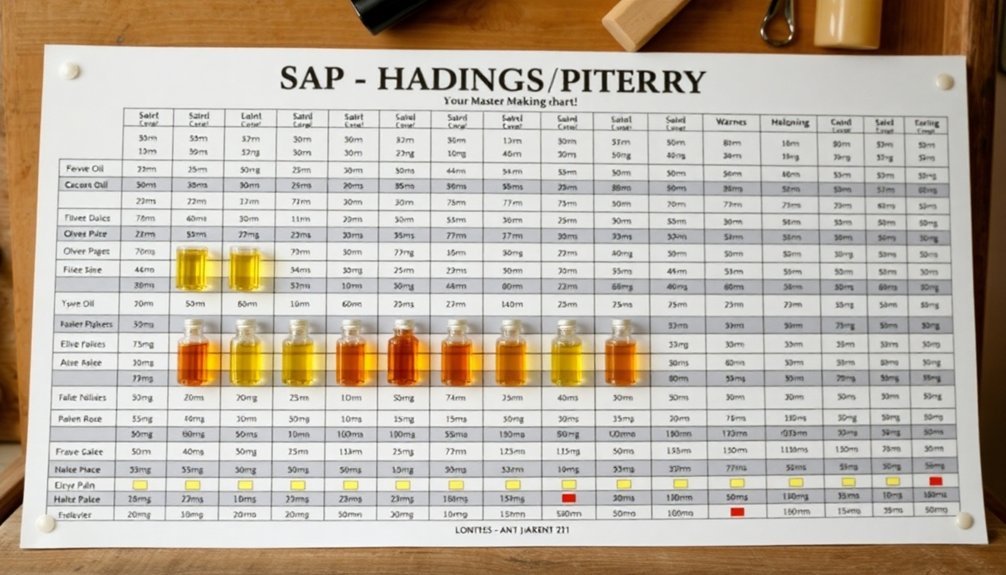
When crafting a lasting soap bar, you'll need to choose your oils strategically for best hardness and durability.
Your formula should include 15-50% coconut oil or 25-50% palm oil to establish structural integrity that won't dissolve quickly during use.
Balancing these hard oils with softer varieties creates the ideal combination for a bar that maintains its shape while delivering your desired cleansing properties.
Bar Strength Fundamentals
Durability, a critical quality in any handmade soap, depends largely on your selection of oils. The balance between hard oils and soft oils determines how long your bars will last in the shower.
Coconut oil and palm oil, with their low saponification values, create the structural integrity that prevents your soap from dissolving too quickly.
To create stronger, longer-lasting bars:
- Incorporate 15-50% coconut oil to increase hardness while maintaining conditioning properties
- Balance with 25-50% palm oil to enhance structural integrity without sacrificing gentleness
- Monitor the iodine values of your oils—lower values (like coconut at 10.4) contribute to hardness while higher values (olive at 81.1) add moisturizing benefits
Durability Oil Balance
Crafting a soap that holds up in the shower takes careful attention to your oil selection ratios. For ideal durability, aim for at least 25% hard oils in your formulation. Coconut oil (iodine value 10.4) and palm oil (54.2) contribute greatly to bar hardness, creating a soap that resists dissolving quickly during use.
The longevity of your bars depends largely on fatty acid saturation levels. Ingredients like lard and tallow provide exceptional staying power by reinforcing soap structure at a molecular level.
However, don't sacrifice lather and conditioning properties by using hard oils exclusively.
The secret to long-lasting soap lies in balancing hard oils for durability with soft oils for skin benefits. This combination guarantees your soap maintains its integrity through multiple uses while still delivering the moisturizing properties your skin deserves.
Cleansing Properties and Moisture Retention
The delicate balance between cleansing power and moisture retention forms the cornerstone of effective soap formulation. Your soap recipe's cleansing properties largely depend on your oil choices—hard oils like coconut oil provide strong cleansing and lather but can be drying, while soft oils like olive oil offer gentler cleansing that preserves natural moisture.
To achieve the perfect balance in your soap:
- Monitor iodine values – Oils with higher values (safflower) create milder cleansing while lower values (coconut) yield stronger cleansing action.
- Adjust your superfat level when using higher percentages of cleansing oils to prevent over-stripping skin.
- Incorporate conditioning oils like avocado to create a moisture barrier that counteracts the potential drying effects of cleansing agents.
Calculating the Perfect Oil Blend Ratio
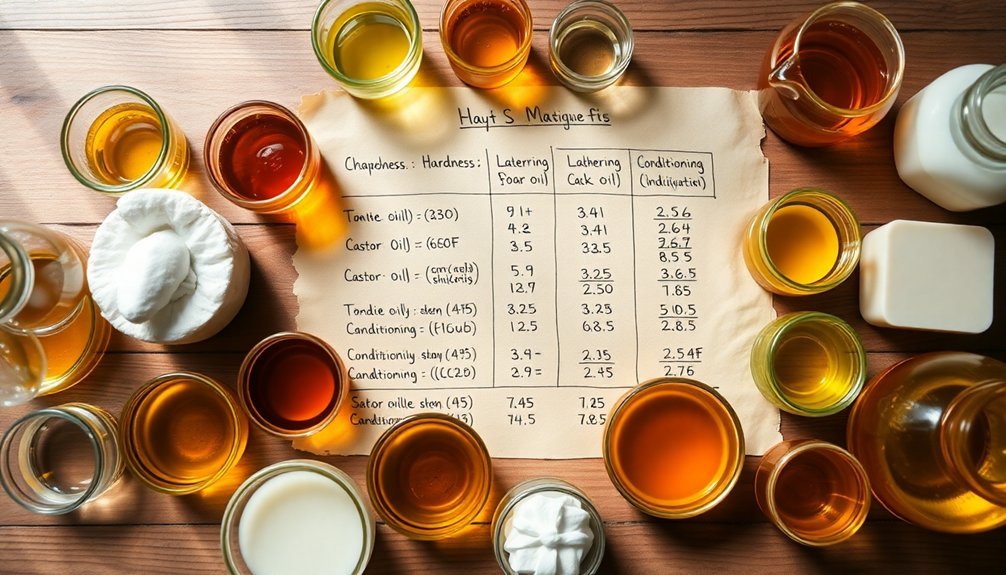
Finding the perfect oil blend ratio transforms your soap from a simple cleansing product into a customized bar with precisely balanced properties.
Start by identifying your desired soap characteristics, then select oils that contribute those qualities.
Use a lye calculator to determine the correct amount of lye needed, as each oil has a unique saponification value.
For balanced soap, aim for 30-50% hard oils (coconut, palm) for firmness and 50-70% soft oils (olive, avocado) for moisturizing properties.
Always respect maximum usage rates—15-50% for coconut oil and 25-80% for olive oil—to avoid issues like excessive dryness or poor lather.
Create small test batches to fine-tune your oil blend ratios, documenting results to perfect your formula.
Essential Fatty Acid Profiles and Their Effects
Understanding fatty acid profiles gives you powerful control over your soap's properties. Different oils contribute unique essential fatty acids that directly impact your soap's performance and skin benefits. The balance between omega-3 and omega-6 fatty acids particularly influences how your soap treats the skin.
- Omega-6 rich oils (safflower, sunflower) enhance moisturizing properties but require balanced formulation to avoid potential inflammation.
- Omega-3 dominant oils (flaxseed) provide anti-inflammatory benefits that soothe irritated skin while supporting the skin's natural barrier.
- Balanced fatty acid profiles affect lathering properties and hardness – saturated fatty acids create harder bars with stronger cleansing, while unsaturated fatty acids improve conditioning.
Substitution Guide: Finding Comparable Oil Alternatives
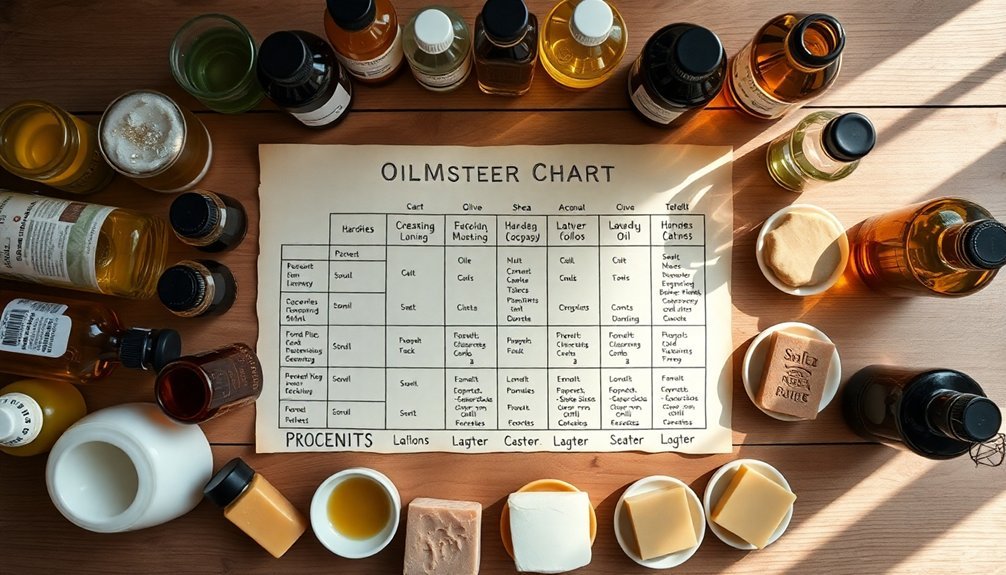
Three essential factors govern successful oil substitutions in soap making: saponification values, fatty acid profiles, and physical properties. When you're out of a specific oil, you can substitute alternatives with similar characteristics, but you must recalculate your recipe using a lye calculator to account for different saponification values.
| Original Oil | Substitute Options | Properties |
|---|---|---|
| Olive Oil | High-oleic sunflower oil | Moisturizing, medium lather |
| Coconut Oil | Babassu oil | High cleansing, fluffy lather |
| Palm Oil | Tallow or lard | Hardness, stable lather |
Remember that fatty acid profiles determine your soap's fundamental properties. A coconut oil substitute should provide similar cleansing and lathering abilities, while olive oil alternatives should maintain moisturizing qualities. Even small adjustments in oil ratios can greatly impact your soap's hardness, lather quality, and skin feel.
Balancing Conditioning Oils With Cleansers
Creating a successful soap formula requires you to find the sweet spot between conditioning oils like olive oil (25-80%) and cleansing oils like coconut oil (15-50%) to achieve both skin nourishment and effective cleaning power.
You'll want to combine harder oils for structure with softer conditioning oils to prevent your soap from stripping away natural moisture, especially if you're formulating for sensitive skin.
When you pair high-cleansing oils with complementary conditioning oils like castor, you'll enhance lather while maintaining the ideal balance that keeps skin hydrated and clean.
Cleansing vs. Moisture Balance
When formulating soap recipes, you'll need to master the delicate balance between cleansing and conditioning properties. High amounts of cleansing oils like coconut oil (15-50%) provide abundant lather but can strip moisture from sensitive skin when overused. Counterbalance this by incorporating conditioning oils like olive oil (25-80%) to maintain an ideal moisture balance.
The perfect soap combines hard oils and soft oils in proportions that create:
- A bar firm enough to last but gentle enough for daily use
- Sufficient cleansing properties without drying the skin
- Rich, creamy lather that leaves skin feeling nourished
Remember that hard oils set quickly, while conditioning oils slow trace time—giving you more design flexibility while ensuring your final product delivers both cleansing action and moisture retention.
Formulating Synergistic Combinations
The art of combining oils synergistically elevates your soap from merely functional to truly exceptional.
Creating effective formulations requires balancing high cleansing oils with conditioning ones—like pairing coconut oil (30%) with olive oil (70%) to clean efficiently while maintaining moisture.
The 30:70 ratio of hard oils to soft oils offers an ideal foundation for most recipes. Coconut oil provides cleansing power at 15-50% of your formulation, while olive oil contributes conditioning benefits at 25-80%.
For enhanced lathering, incorporate 5-10% castor oil alongside your primary ingredients.
Soft oils like avocado counteract the potential drying effects of cleansing oils, creating true synergy in your soap.
Always check saponification values when mixing oils to verify your formulation delivers the perfect balance of cleansing and conditioning properties.
Temperature Considerations for Different Oil Types
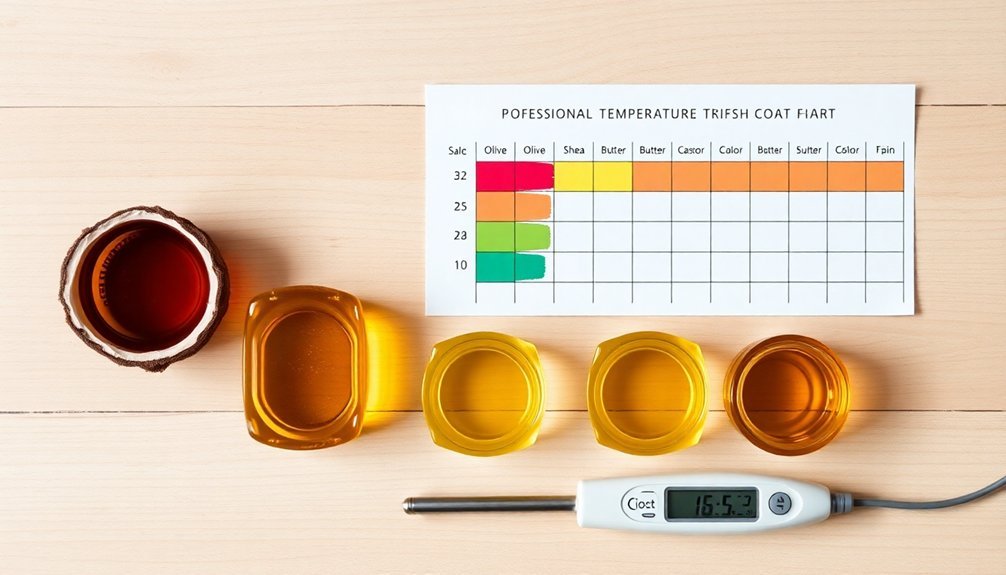
Since each oil type responds differently to heat, understanding temperature requirements is crucial for successful soap making.
When working with hard oils like coconut and palm, you'll need higher temperatures during mixing to prevent false trace and guarantee complete saponification. Conversely, soft oils such as olive and castor allow for lower temperature processing, giving you more time to create intricate designs.
For best results, remember these temperature guidelines:
- Hard and brittle oils (coconut, palm, cocoa butter) – Mix at higher temperatures to prevent premature solidification
- Soft oils (olive, castor) – Can be processed at lower temperatures for extended working time
- Formulations with high percentage of soft oils – Freeze these oils before mixing for easier unmolding later
Monitoring temperatures carefully will help you avoid false trace issues that can complicate your design process.
Trace Time and Setting Speed by Oil Category
Understanding how different oils affect trace time can dramatically improve your soap making success. When formulating recipes, you'll notice that hard oils like coconut oil accelerate trace, while soft oils like olive oil slow the process down.
| Oil Category | Trace & Setting Characteristics |
|---|---|
| Hard Oils | Quick trace times, fast setting speeds; ideal for beginners |
| Soft Oils | Slow trace times; perfect for intricate designs |
| Brittle Oils | Create hard bars but may cause false trace if temperatures aren't managed |
| Oil Ratios | Higher percentages of hard oils speed up trace; soft oils slow it down |
Remember that monitoring oil temperatures is essential, especially when working with hard oils. If they're too cool, you might experience false trace where the oils solidify before actual saponification begins. By understanding these relationships, you'll gain better control over your soapmaking process.
Specialty Oils: Luxury Additions and Their Benefits
Elevating your soap beyond the basics often involves incorporating specialty oils that transform ordinary bars into luxurious skin treatments.
While olive oil creates a solid foundation, specialty oils like jojoba, argan, and rosehip add therapeutic properties that make your soap extraordinary.
These luxury additions offer specific skin benefits:
- Superior moisturizing – Avocado and macadamia nut oils penetrate deeply, improving skin elasticity and providing long-lasting hydration for mature skin.
- Healing properties – Rosehip oil's vitamin A and antioxidants reduce scarring and fine lines, rejuvenating your skin's appearance.
- Lightweight conditioning – Apricot kernel oil soothes without greasiness, while jojoba closely mimics your skin's natural sebum for balanced moisture.
Adding just 5-10% of these specialty oils can dramatically enhance your soap's skin-nourishing potential.
Frequently Asked Questions
What Oil Makes the Hardest Bar of Soap?
Coconut oil creates the hardest soap bars, especially at higher percentages. You'll get a durable, long-lasting product with abundant lather. Palm oil also produces firm bars, while lard and tallow contribute significant hardness too.
What Are Considered Hard Oils in Soap Making?
In soap making, you'll recognize coconut oil, palm oil, lard, and tallow as hard oils. They're essential for creating solid, long-lasting bars. These oils contribute firmness to your soap and typically set more quickly during curing.
What Is the Best Oil for Cleansing Soap Making?
Coconut oil is your best choice for cleansing soap. It creates abundant lather with fluffy bubbles and has high cleansing properties. You'll get excellent results using it at 15-50% in your soap recipes.
What Is the Best Super Fat Percentage for Soap Making?
You'll find 5-8% super fat works best for most soaps, balancing cleansing with moisturizing. If you're making soap for sensitive skin, you can increase to 8-10% for extra conditioning without becoming too greasy.
In Summary
You've now got a roadmap to navigate the complex world of soap making oils. Whether you're seeking bubbly lather, skin-loving conditioning, or long-lasting bars, selecting the right oils makes all the difference. Remember to balance your hard and soft oils while considering trace time and temperature needs. With this master chart as your guide, you'll create soaps tailored perfectly to your preferences.

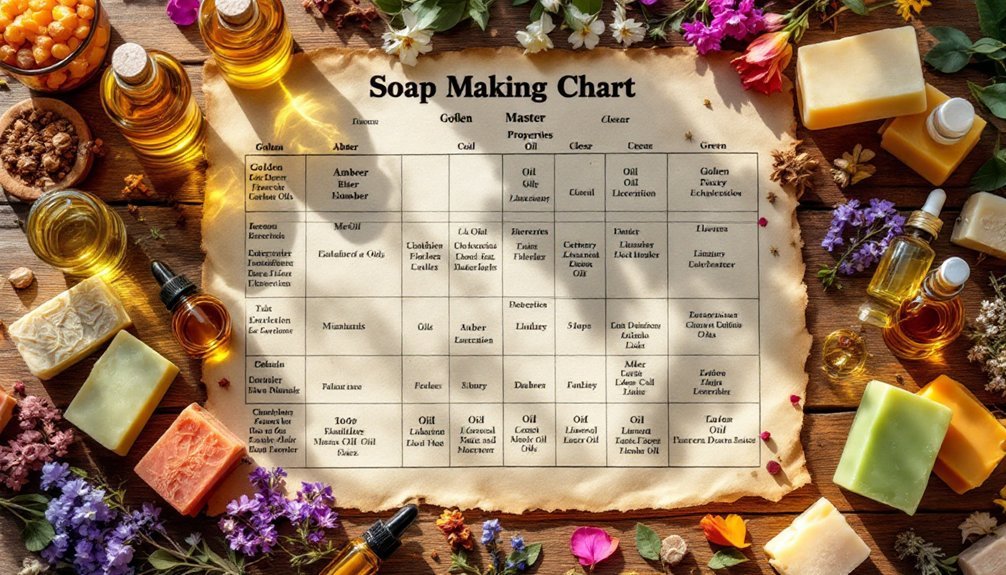



Leave a Reply